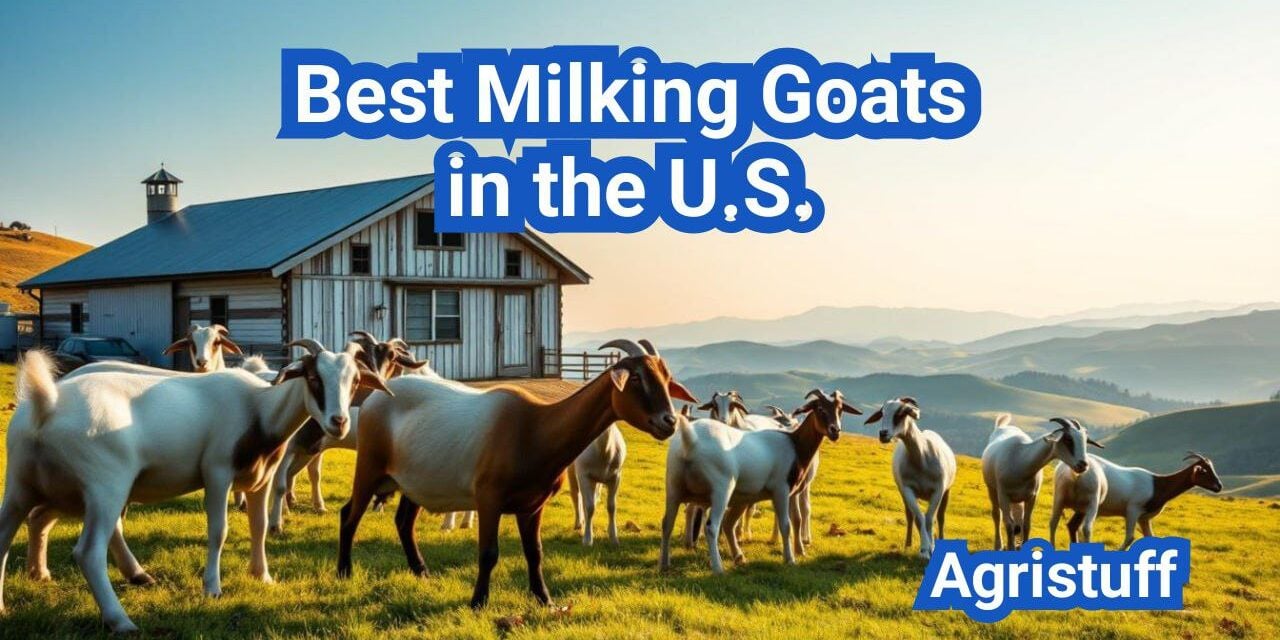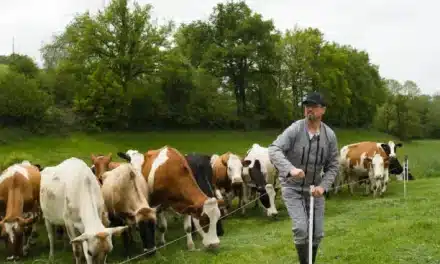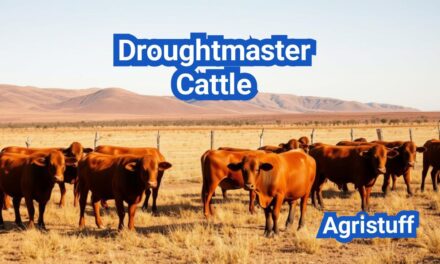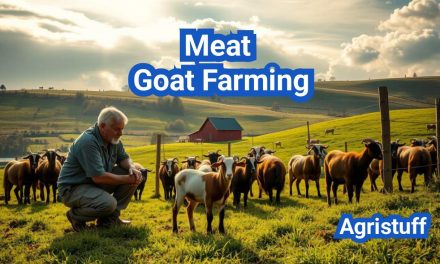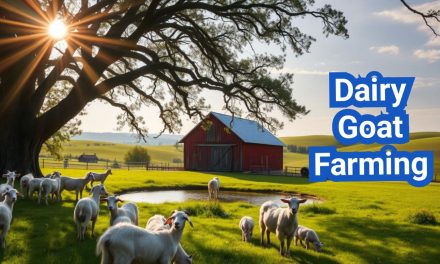For many families in the United States, dairy goats are a valuable resource for fresh milk, cheese, and butter. With several breeds to choose from, selecting the right one can be a daunting task.
The Saanen, Alpine, and Nigerian Dwarf goats are among the top milk-producing breeds ( Best Milking Goats ) , known for their high milk yields and rich butterfat content. These breeds are particularly popular among small-scale dairy farmers due to their manageable size and high productivity.
Understanding the characteristics of these breeds is crucial for making an informed decision. This article will explore their milk production capabilities, butterfat percentages, and suitability for family dairy setups.
Key Takeaways
- Top dairy goat breeds for milk production in the U.S.
- Milk yields and butterfat content of Saanen, Alpine, and Nigerian Dwarf goats
- Suitability of these breeds for family dairy setups
- Characteristics of high-producing dairy goat breeds
- Factors to consider when choosing a dairy goat breed
The Value of Dairy Goats for Home Milk Production
Dairy goats offer numerous benefits for home milk production, making them an attractive choice for many households. Raising dairy goats can provide a family with a steady supply of fresh milk, potentially saving on dairy product costs. Moreover, goat milk is rich in nutrients and is often easier to digest than cow milk, making it a great alternative for those with dairy intolerance.
Economic Benefits of Raising Dairy Goats
Raising dairy goats for home milk production can be economically beneficial. The initial investment in a dairy goat can pay off over time through the savings on milk and other dairy products. Additionally, families can benefit from the sale of surplus milk or dairy products, such as cheese and butter, to neighbors or at local farmers’ markets. As one dairy farmer notes, “
Raising dairy goats has not only provided us with fresh milk but has also become a small business opportunity.
“
The economic benefits extend beyond just milk production. Dairy goats can also contribute to a family’s overall food security by providing manure for fertilizer, which can be used in gardening and farming. This holistic approach to farming can significantly reduce a family’s reliance on external food sources.
Comparing Goat Milk to Cow Milk
When it comes to nutritional value, goat milk stands out from cow milk in several ways. Goat milk contains a higher proportion of certain nutrients, such as calcium, potassium, and vitamin A, making it a nutritious choice for families. Moreover, the fat molecules in goat milk are smaller than those in cow milk, which can make it easier to digest for individuals with cow milk intolerance or sensitivity.
Another significant advantage of goat milk is its potential for producing high-quality dairy products. The rich flavor and creamy texture of goat milk make it ideal for cheese production, and many dairy goat owners enjoy making their own cheese, butter, and yogurt at home. As goat milk enthusiasts can attest, the taste and nutritional benefits of these products are well worth the effort.
In conclusion, dairy goats offer a valuable resource for families looking to produce their own milk at home. With their economic benefits, nutritional advantages, and potential for producing a variety of dairy products, it’s no wonder that dairy goats are becoming an increasingly popular choice for home milk production.
What Makes a Great Dairy Goat: Essential Characteristics

A great dairy goat possesses a combination of physical and behavioral traits that make it ideal for milk production. The right characteristics can significantly impact the overall productivity and efficiency of a dairy goat operation.
Physical Traits of Productive Milkers
Productive dairy goats typically exhibit robust physical traits. A well-structured udder is crucial for high milk production. The udder should be well-attached, with a good balance between the two halves and teats that are appropriately sized for milking. Additionally, a strong, sturdy build contributes to the goat’s overall health and productivity.
Other physical attributes include a straight or slightly dished profile, a deep chest, and well-sprung ribs. These traits are indicative of a goat’s ability to produce milk efficiently. The overall physical condition of the goat is a good indicator of its potential milk production capabilities.
Temperament Considerations
A calm and friendly temperament is essential for dairy goats. Goats that are easy to handle and less stressed are more likely to produce higher quality milk. A good temperament also makes milking and daily care easier for farmers.
Temperament can vary between breeds and individuals. Some breeds are known for their docile nature, making them ideal for family dairy setups or beginners. Selecting goats with a calm temperament can significantly enhance the overall dairy operation.
Lactation Period and Persistence
The lactation period and persistence of milk production are critical factors in determining a dairy goat’s productivity. A longer lactation period allows for more extended milk production, reducing the need for frequent breeding cycles.
Persistence refers to the goat’s ability to maintain milk production levels throughout its lactation cycle. Goats with high persistence require less intensive management and can provide a more consistent milk supply. Breeding programs often focus on selecting for these traits to improve overall dairy efficiency.
Understanding Milk Yields and Butterfat Content
Understanding the milk production capabilities and butterfat percentages of dairy goats is essential for successful dairy operations. Different breeds exhibit varying levels of milk production and butterfat content, influenced by genetics, nutrition, and management practices.
Average Production Expectations
Dairy goat breeds have distinct average milk production levels. For instance, the Saanen breed is known for its high milk yield, often producing over 2,000 pounds of milk per year. In contrast, the Nigerian Dwarf breed produces less milk volume but with higher butterfat content.
Average milk production expectations are crucial for farmers to plan their dairy operations effectively. Breeds like Alpine and LaMancha are also recognized for their significant milk production capabilities.
Factors Affecting Butterfat Percentages
Butterfat content in goat milk is influenced by several factors, including diet, breed, and stage of lactation. Nutritional management plays a critical role, as diets high in fiber tend to increase butterfat percentages. Additionally, the stage of lactation affects butterfat content, typically decreasing as lactation progresses.
- Dietary fiber content
- Breed characteristics
- Stage of lactation
- Health and management practices
Seasonal Variations in Production
Seasonal changes can significantly impact milk production in dairy goats. Factors such as temperature, humidity, and feed availability vary with the seasons, influencing milk yield and composition. For example, hot weather can decrease milk production, while changes in feed quality can affect butterfat content.
Understanding these seasonal variations allows farmers to adjust their management practices to optimize milk production and quality throughout the year.
Saanen: The Holstein of Goats

Saanen goats, often referred to as the ‘Holstein of goats,’ are prized for their high milk yields and calm demeanor. This breed has gained popularity worldwide for its exceptional dairy production capabilities.
Production Statistics and Records
Saanen goats are known for their impressive milk production. On average, a Saanen goat can produce between 800 to 1,200 kg of milk per lactation period, which typically lasts around 280 to 300 days. The breed’s milk is characterized by its high volume and relatively low butterfat content, making it suitable for various dairy products.
Notable production records:
- Average milk yield per lactation: 800-1,200 kg
- Lactation period: 280-300 days
- Butterfat content: Relatively low, typically around 3-4%
Temperament and Handling Characteristics
One of the standout features of Saanen goats is their calm and docile nature. This temperament makes them easy to handle, even for those who are new to dairy farming. Their gentle disposition also contributes to a stress-free milking environment, which is crucial for maintaining high milk production.
“Saanen goats are known for their friendly and docile nature, making them an excellent choice for dairy operations of all sizes.”
Ideal Setup for Saanen Goats
To maximize the production potential of Saanen goats, it’s essential to provide them with a well-managed setup. This includes adequate nutrition, proper health care, and comfortable living conditions. A well-designed dairy operation will ensure that the goats receive the necessary care to thrive and produce high-quality milk.
Key considerations for an ideal Saanen goat setup:
- Nutritional balance: Providing a diet that meets their nutritional needs
- Health care: Regular veterinary check-ups and preventative care
- Living conditions: Comfortable housing with adequate space and ventilation
Alpine Goats: Versatile and Productive
Alpine goats are renowned for their versatility and high milk production, making them a popular choice among dairy farmers. Their ability to thrive in various environments and produce high-quality milk has made them a staple in many dairy operations.
Differences Between French and American Alpines
The Alpine breed is not homogeneous; it includes distinct strains such as the French Alpine and the American Alpine. While both are known for their milk production, there are notable differences between them. French Alpines are often considered to have a more refined dairy characteristic, whereas American Alpines have been bred for their hardiness and productivity in a variety of conditions.
Understanding these differences is crucial for dairy farmers who are deciding which strain to incorporate into their operations. The choice between French and American Alpines can affect milk production levels, flavor, and overall farm management.
Milk Flavor and Composition
The milk produced by Alpine goats is highly regarded for its quality and flavor. The composition of the milk, including its butterfat content, can vary depending on factors such as diet, genetics, and management practices. Generally, Alpine goats produce milk with a butterfat content that is well-suited for cheese production and other dairy products.
The flavor profile of the milk is also an important consideration. Alpine goat milk is known for its mild flavor, making it a versatile choice for various dairy applications.
Management Requirements for Optimal Production
To maximize the milk production potential of Alpine goats, effective management practices are essential. This includes providing a balanced diet, ensuring access to clean water, and maintaining a healthy living environment. Regular veterinary care and a well-planned breeding program are also critical components of successful Alpine goat dairy farming.
By understanding and implementing these management requirements, dairy farmers can optimize the productivity and health of their Alpine goats, leading to a successful and sustainable dairy operation.
Nubian Goats: The Butterfat Queens

With their distinctive appearance and exceptional milk quality, Nubian goats stand out in the dairy goat world. Known for their high butterfat content, Nubian goats are particularly well-suited for cheese production, making them a favorite among dairy farmers and cheesemakers alike.
Distinctive Features and Characteristics
Nubian goats are easily recognizable due to their unique appearance, which includes their long, drooping ears and Roman nose. They come in a variety of colors and patterns, making each Nubian goat distinct. Their friendly and outgoing personalities also set them apart, as they are known to be quite vocal and interactive.
Milk Quality for Cheese Making
The milk of Nubian goats is renowned for its high butterfat content, typically ranging between 4.5% to 5%, which is ideal for producing rich, creamy cheeses. The quality of their milk, combined with their relatively high milk production, makes Nubian goats an excellent choice for dairy operations focused on cheese making.
| Characteristic | Nubian Goats |
|---|---|
| Butterfat Content | 4.5% – 5% |
| Milk Production | High |
| Temperament | Friendly, Vocal |
Handling Vocal Personalities
Nubian goats are known for their vocal nature, often communicating with their human caregivers and other goats. While this can be endearing, it also requires patient handling and understanding. Their friendly disposition makes them a joy to work with, but it’s essential to establish clear communication and boundaries to manage their vocal personalities effectively.
LaMancha Goats: Efficient and Adaptable Producers

LaMancha goats stand out in the dairy goat world due to their distinctive appearance and reliable milk production. This breed has gained popularity among dairy farmers for its unique characteristics and consistent performance.
Unique Ear Characteristics and Recognition
One of the most distinctive features of LaMancha goats is their earlessness or significant reduction in ear size. This characteristic is a result of a natural mutation and has become a defining trait of the breed. The American Dairy Goat Association (ADGA) recognizes two types of ear configurations for LaMancha goats: “gopher ears” (extremely short ears with little or no cartilage) and “elf ears” (slightly longer ears with more cartilage, but still significantly shorter than other breeds). This unique feature makes LaMancha goats easily identifiable.
Production Consistency Benefits
LaMancha goats are known for their consistent milk production, making them a reliable choice for dairy farming. They offer a rich source of high-quality milk, with butterfat content that is suitable for various dairy products. The breed’s production consistency is a significant advantage for farmers who need a steady supply of milk for cheese, butter, and other dairy products.
Reliable milk production is crucial for dairy farmers, and LaMancha goats deliver on this front. Their ability to maintain consistent production levels throughout their lactation period makes them an attractive choice for both small-scale and commercial dairy operations.
Family-Friendly Temperament
LaMancha goats are also recognized for their friendly and docile nature, making them an excellent choice for family dairy setups. Their temperament is generally calm and cooperative, which simplifies handling and milking processes. This breed is particularly suitable for farms with children, as they are gentle and easy to manage.
The family-friendly nature of LaMancha goats adds to their appeal, allowing families to be involved in the dairy farming process without concerns about aggressive behavior from the animals.
Nigerian Dwarf Goats: Small-Scale Dairy Champions
With their unique blend of size, productivity, and milk quality, Nigerian Dwarf goats are a top choice for small dairy farms. These compact goats are not only efficient in terms of space but also produce rich, high-quality milk ideal for dairy products.
Space-Efficient Housing Solutions | Best Milking Goats
Nigerian Dwarf goats require significantly less space compared to larger dairy goat breeds, making them perfect for small farms or homesteads. Their compact size allows for flexible housing solutions, from small barns to fenced pastures.
Efficient housing for Nigerian Dwarf goats can be achieved through various designs, including mini barns or converted sheds, ensuring they have enough room to move and exercise. Adequate ventilation and dry bedding are crucial for their health and milk production.
Impressive Butterfat Content | Best Milking Goats
One of the standout features of Nigerian Dwarf goats is their milk’s high butterfat content, typically ranging between 6-10%. This rich milk is particularly suited for producing cheese, butter, and other dairy products.
The high butterfat content not only enhances the flavor but also increases the yield of dairy products, making Nigerian Dwarf goats an economically viable choice for small-scale dairy production.
Multiple Kidding Possibilities | Best Milking Goats
Nigerian Dwarf goats are known for their prolific breeding capabilities, often having twins or triplets. This multiple kidding trait allows farmers to quickly expand their herd and maintain a consistent milk supply.
Effective breeding management is crucial to maximize the benefits of multiple kidding. By staggering breeding schedules, farmers can ensure a steady supply of milk throughout the year, catering to both personal consumption and potential market demands.
Best Milking Goats for Specific Situations

The best milking goats can vary significantly based on specific needs and circumstances. Different breeds excel in various areas, making some more suitable for your particular situation than others.
Top Breeds for Beginners | Best Milking Goats
For those new to dairy goat farming, breeds like Saanen and Alpine are often recommended. These breeds are known for their ease of handling and high milk production.
- Saanen goats are recognized for their calm temperament and high milk yields, making them an excellent choice for beginners.
- Alpine goats are versatile and productive, with a friendly disposition that suits novice farmers.
Ideal Choices for Limited Space | Best Milking Goats
For operations with limited space, the Nigerian Dwarf goat is an excellent option. Despite their smaller size, they produce rich milk with high butterfat content.
- Nigerian Dwarfs are compact and require less space, making them ideal for small farms or homesteads.
- Their milk is perfect for cheese production and other dairy products.
Best Options for Family Handling | Best Milking Goats
Breeds like LaMancha are known for their friendly and outgoing personalities, making them suitable for family handling.
- LaMancha goats are easy-going and can be a great addition to family farms, providing both milk and companionship.
- Their temperament makes them an excellent choice for households with children.
By choosing the right dairy goat breed for your specific situation, you can ensure a successful and productive milking operation.
Climate Considerations for Dairy Goat Selection

The success of your dairy goat operation heavily depends on selecting breeds adapted to your local climate. Different climates can significantly impact the health, productivity, and milk production of dairy goats.
Understanding the climate-specific needs of dairy goats is crucial for maintaining their well-being and optimizing milk yields. Certain breeds are more suited to hot or cold climates, and selecting the right breed for your climate is essential.
Best Milk Goats for Hot Climates
In regions with high temperatures and humidity, dairy goat breeds that are heat-tolerant and resistant to parasite infestations are preferred. The Nubian breed is known for its tolerance to hot climates, making it an excellent choice for dairy farming in warmer regions.
Other breeds that perform well in hot climates include the LaMancha and Toggenburg, which are known for their hardiness and ability to adapt to various environmental conditions.
Best Milk Goats for Cold Climates
In colder climates, dairy goat breeds with thick coats and a robust constitution are more likely to thrive. The Alpine breed, while adaptable to various climates, does well in cooler temperatures and is known for its high milk production.
Other cold-hardy breeds include the Saanen and Oberhasli, which are recognized for their ability to withstand cold temperatures and maintain productivity.
By choosing dairy goat breeds that are well-suited to your local climate, you can ensure a healthier and more productive dairy operation.
Setting Up Your Family Dairy Goat Operation

Creating a thriving family dairy goat operation starts with understanding the basics. A successful dairy goat farm requires careful planning, adequate space, proper housing, and a well-designed milking station. These elements are crucial for the health and productivity of the goats, as well as the overall success of the dairy operation.
Minimum Space Requirements | Best Milking Goats
When setting up a dairy goat operation, one of the first considerations is the minimum space required. Goats need room to move, exercise, and graze. A general rule of thumb is to provide at least 1/4 acre per goat for grazing and exercise, though this can vary depending on breed, size, and local regulations.
For housing, a minimum of 15-20 square feet per goat is recommended. This space should be well-ventilated, dry, and protected from the elements. Adequate space not only improves the welfare of the goats but also enhances milk production.
| Number of Goats | Grazing/Exercise Space (acres) | Housing Space (sq ft) |
|---|---|---|
| 5 | 1.25 | 75-100 |
| 10 | 2.5 | 150-200 |
| 15 | 3.75 | 225-300 |
Essential Housing Features | Best Milking Goats
The housing for your dairy goats should be designed with several key features in mind. First, it should be well-ventilated to prevent respiratory issues. Second, it should be dry and draft-free to keep the goats comfortable. Third, it should have adequate lighting, both natural and artificial, to facilitate milking and daily care tasks.
“A clean and dry environment is crucial for maintaining the health of dairy goats. Moisture can lead to hoof problems and other health issues.”
Additionally, the housing should include features such as:
- Individual stalls or pens for kidding and sick goats
- A milking area that is easy to clean and maintain
- Storage for hay, grain, and equipment
Milking Station Setup | Best Milking Goats
A well-designed milking station is critical for efficient and hygienic milking. The station should be equipped with a stanchion or milking stand to restrain the goat during milking, reducing stress and improving milking efficiency.
The milking area should be designed to minimize the risk of contamination. This includes using materials that are easy to clean and sanitize, such as stainless steel and concrete. Good lighting is also essential to facilitate the milking process and to inspect the udders and milk.
To raise milking goats efficiently, it’s also important to consider the workflow in the milking station. This includes having a logical sequence of operations, from preparation to milking to post-milking care, to streamline the process and reduce labor.
Step-by-Step Milking Process for Beginners

For those new to dairy goat farming, understanding the milking process is crucial for success. Proper milking technique is essential for maintaining milk quality and goat health.
Preparing Your Goat for Milking
Before milking, it’s essential to prepare your goat to ensure a smooth and stress-free process. This involves cleaning the udder and teats, checking for any signs of illness or infection, and providing a comfortable milking environment.
- Clean the udder and teats with a mild detergent and warm water.
- Inspect the udder for any signs of mastitis or other infections.
- Provide a clean and comfortable milking area.
Hand Milking Technique | Best Milking Goats
Hand milking is a traditional method that requires skill and practice to master. The key is to be gentle yet firm, ensuring that the milk flows freely without causing discomfort to the goat.
- Hold the teat in your hand, with your thumb and index finger forming a “C” shape.
- Gently squeeze the teat to trap the milk, then release the pressure to allow the milk to flow.
- Repeat this process, milking in a rhythmic motion.
Using Small-Scale Milking Machines
For those with multiple goats or a larger dairy operation, small-scale milking machines can be a valuable investment. These machines can help streamline the milking process, reducing labor and improving efficiency.
| Milking Machine Feature | Benefit |
|---|---|
| Pulsation System | Mimics hand milking, reducing stress on the goat. |
| Adjustable Vacuum | Allows for customization based on the goat’s needs. |
| Sanitizing System | Helps maintain cleanliness and reduces the risk of infection. |
By following these steps and considering the use of milking machines, beginners can establish an effective milking routine that prioritizes both milk quality and goat well-being.
Feeding for Maximum Milk Production

Maximizing milk production in dairy goats starts with understanding their nutritional needs. A balanced diet that includes appropriate forages and concentrates is vital for maximizing milk production.
Basic Nutritional Requirements | Best Milking Goats
Dairy goats require a diet rich in nutrients to support their milk production. The basic nutritional requirements include a mix of proteins, carbohydrates, fats, vitamins, and minerals. Adequate protein intake is crucial for milk production, as it supports the synthesis of milk proteins.
The quality of forage is also critical, as it directly impacts the nutritional value of the diet. High-quality forages such as alfalfa or clover are rich in proteins and other essential nutrients.
Forage vs. Concentrate Balance | Best Milking Goats
Achieving the right balance between forage and concentrate is essential for maximizing milk production. Forages provide fiber, which is crucial for maintaining a healthy rumen, while concentrates offer a concentrated source of energy and nutrients.
A general guideline is to provide a mix that is 50-60% forage and 40-50% concentrate on a dry matter basis, though this can vary depending on the goat’s production level and stage of lactation.
Supplements for Milk Quality | Best Milking Goats
In addition to a balanced diet of forages and concentrates, certain supplements can enhance milk quality. For example, adding omega-3 fatty acids can improve the fatty acid profile of the milk, making it more desirable for consumers.
Vitamins and minerals are also important supplements, as they support overall health and can impact milk quality. Ensuring that dairy goats receive adequate levels of vitamins such as vitamin E and minerals like selenium is crucial.
By understanding and implementing these feeding strategies, dairy goat farmers can maximize milk production while maintaining the health and well-being of their animals.
Managing Breeding for Consistent Milk Supply
Managing the breeding of dairy goats is a critical aspect of maintaining a consistent milk supply. Effective breeding management involves several key strategies that dairy goat farmers must implement to ensure a steady milk production throughout the year.
Breeding Schedule Planning | Best Milking Goats
Planning a breeding schedule is the first step in managing a dairy goat operation. This involves deciding when to breed your does to achieve optimal freshening dates. A well-planned breeding schedule ensures that your goats are bred at the right time to maximize milk production during the desired periods.
- Determine the optimal breeding time based on the breed and individual goat characteristics.
- Use a breeding calendar to keep track of breeding and freshening dates.
- Consider the gestation period of your goats, typically around 150 days, when planning your breeding schedule.
Staggering Freshening Dates | Best Milking Goats
Staggering freshening dates is a technique used to ensure a consistent milk supply throughout the year. By breeding your goats at different times, you can achieve a staggered freshening schedule that provides a steady milk production.
This approach has several benefits, including:
- A consistent milk supply for dairy product manufacturing or family consumption.
- Reduced pressure on the milking routine during peak production periods.
- Better utilization of resources, such as equipment and labor.
Buck Management Options | Best Milking Goats
Effective buck management is crucial for the success of a dairy goat breeding program. Bucks play a vital role in the breeding process, and their health and well-being directly impact the fertility of the does.
Consider the following buck management options:
- Maintain a healthy buck-to-doe ratio to ensure successful breeding.
- Provide regular veterinary care, including vaccinations and parasite control, for your bucks.
- Consider leasing or sharing a buck with other breeders to reduce costs and improve genetic diversity.
By implementing these strategies, dairy goat farmers can effectively manage their breeding programs to achieve a consistent milk supply. This not only enhances the overall productivity of the dairy operation but also contributes to its long-term sustainability.
Selecting Your Ideal Dairy Goat
Selecting the ideal dairy goat breed is a crucial decision that depends on several factors, including milk production needs, climate adaptability, and handling characteristics. By understanding the unique qualities of different breeds, dairy goat farmers can make informed decisions that contribute to the success of their dairy operation.
When choosing the right dairy goat breed, consider your specific needs and circumstances. For instance, if you live in a hot climate, breeds like the Alpine or LaMancha may be suitable due to their heat tolerance. On the other hand, if you’re looking for high butterfat content, Nubian or Nigerian Dwarf goats might be the best choice.
The best dairy goat breeds are those that align with your production goals, climate, and handling preferences. By matching your needs with the characteristics of different breeds, you can create a thriving dairy goat operation that meets your needs and provides a rewarding experience.
Ultimately, selecting dairy goats that fit your operation’s unique requirements is key to achieving success in dairy goat farming. By considering the factors outlined in this article, you can make an informed decision and enjoy the benefits of fresh, high-quality milk from your ideal dairy goat breed.
FAQ
What are the best milking goat breeds for a family dairy setup?
The best milking goat breeds for a family dairy setup include Saanen, Alpine, LaMancha, and Nigerian Dwarf goats, known for their high milk production, friendly temperament, and adaptability.
How much milk can I expect from different dairy goat breeds?
Milk production varies by breed, with Saanen goats producing around 2,000-2,500 pounds per year, Alpine goats producing around 1,800-2,200 pounds per year, and Nigerian Dwarf goats producing around 500-700 pounds per year.
What is the butterfat content of different dairy goat breeds?
Butterfat content varies by breed, with Nubian goats having a higher butterfat content (around 4-5%), while Saanen and Alpine goats have a lower butterfat content (around 3-4%).
How do I choose the right dairy goat breed for my climate?
When choosing a dairy goat breed, consider the climate in your area. Breeds like Nubian are more tolerant of hot climates, while others like Alpine can adapt to a variety of climates.
What are the essential characteristics of a great dairy goat?
A great dairy goat should have a well-structured udder, a robust build, and a calm and friendly temperament, as well as a long lactation period and persistence of milk production.
How do I manage the breeding of my dairy goats for a consistent milk supply?
To manage breeding, plan a breeding schedule, stagger freshening dates, and implement effective buck management practices to ensure a consistent milk supply throughout the year.
What are the nutritional requirements for dairy goats to maximize milk production?
Dairy goats require a balanced diet that includes a mix of forage and concentrate, with supplements used to enhance milk quality. Understanding their nutritional needs is key to a successful dairy operation.
How do I set up a milking station for my dairy goats?
Setting up a milking station involves designing a comfortable and efficient space for milking, with features like a milking stand, proper ventilation, and sanitation facilities.
What are the benefits of raising dairy goats for home milk production?
Raising dairy goats for home milk production offers several benefits, including a steady supply of fresh milk, potential savings on dairy products, and the nutritional benefits of goat milk.
How do I care for my dairy goats to ensure their health and productivity?
Caring for dairy goats involves providing a balanced diet, regular veterinary care, and a clean and comfortable living environment, as well as proper milking practices and management.
Conclusion of: Best Milking Goats in the U.S.
Introduction: Why Best Milking Goats Matter for U.S. Families
Many families searching for the best milking goats in the U.S. want a dependable way to turn pasture, hay, and a modest amount of grain into fresh milk, yogurt, and cheese right at home. Goats are smaller and easier to manage than dairy cows, fit well on small acreages, and can thrive in many different climates across the country.
For homesteaders, hobby farmers, and small agricultural businesses, the best milking goats provide a steady supply of wholesome milk while also offering 4-H and youth project opportunities, brush control, and potential value-added products. Understanding which breeds truly qualify as the best milking goats helps you match your climate, budget, and time to the right animals so you can build a practical family dairy setup from day one. Overview of dairy goats
What Makes the Best Milking Goats? Yield, Butterfat, and Temperament
When people talk about the best milking goats, they are usually thinking about three things: how much milk a doe gives, how rich that milk is, and how pleasant the goats are to live and work with. Most standard dairy breeds can produce from about 1 to 2 gallons of milk per day at peak, while miniature breeds produce less volume but often have much higher butterfat levels.
Butterfat is important because it affects flavor, creaminess, cheese yield, and overall energy content. The best milking goats for your farm balance daily volume with butterfat, fertility, hoof and udder health, and calm temperaments that are easy for a family to handle. By comparing these traits, you can choose the best milking goats that match your goals instead of selecting only by looks or popularity. Goat milk composition and uses
Saanen: High-Volume Workhorses Among the Best Milking Goats
Saanen goats are frequently ranked among the best milking goats in the world because of their impressive milk volume and generally calm temperament. Originating in Switzerland, Saanens are usually all white or cream, with large frames and strong udders that adapt well to machine milking or hand milking. Many U.S. herds report Saanen does giving close to or above 2 gallons of milk per day at peak production under good management, with butterfat typically around 3–3.5 percent.
For families who drink a lot of fluid milk, make yogurt, or sell legal pasteurized milk, Saanens can be some of the best milking goats because they keep production relatively steady throughout the lactation. Their gentle nature also makes them attractive for youth projects and first-time dairy goat owners who want reliable, easygoing best milking goats. Saanen goat breed profile
Alpine and LaMancha: Versatile Best Milking Goats for Diverse Climates
French Alpine and American LaMancha goats are also strong contenders for the title of best milking goats in the U.S. Alpine goats are hardy, medium-to-large animals that handle cold winters, hills, and varied forage very well, making them popular in northern states and mountainous regions.
LaManchas, which were developed in the U.S., are recognized by their very short ears and calm personalities, and they often combine good milk volume with slightly higher butterfat than some Swiss-type breeds. Families who want goats that can cope with both pasture-based and dry-lot systems often find these two breeds to be among the best milking goats because they are adaptable, productive, and usually easy to integrate into small herds with mixed ages and experience levels. Alpine dairy goat information
Nubian: High-Butterfat Stars Among the Best Milking Goats
For many homesteaders, Nubian goats are the best milking goats when the goal is rich, creamy milk with excellent flavor. Nubians are large, long-eared goats with a distinctive Roman nose and a reputation for vocal personalities. While their total volume can be slightly lower than very high-producing Swiss breeds, Nubian milk often contains 4.5–5 percent butterfat or even higher in well-managed lines.
This makes Nubians especially attractive if you want to focus on making cheese, ice cream, butter, or soap, because higher butterfat and solids translate into more product per gallon of milk. Many small farms combine Nubians with other best milking goats, such as Saanens or Alpines, to enjoy both rich and abundant milk and to diversify their genetics and market opportunities. Nubian goat breed overview
Nigerian Dwarf: Compact Best Milking Goats for Small Acreage
Nigerian Dwarf goats have become extremely popular as some of the best milking goats for small backyards, suburban homesteads, and families with limited space. Although they are miniature goats and usually produce less total volume than full-sized dairy breeds, their milk is famously rich, with butterfat often measured between 6 and 10 percent in well-managed herds.
This means a smaller amount of milk from these best milking goats still goes a long way in coffee, smoothies, and homemade cheese. Nigerian Dwarfs are also easier to house in existing sheds, simpler to handle for children, and more affordable to feed. For many beginners, two or three Nigerian Dwarf does offer a practical, lower-impact way to explore the best milking goats without needing a large barn or extensive infrastructure. Nigerian Dwarf goat details
Oberhasli, Toggenburg, and Other Solid Dairy Breeds
Beyond the well-known names, several additional breeds deserve attention on any list of the best milking goats. Oberhasli goats, with their rich bay coloration and black markings, are known for moderate-to-high yields and a calm demeanor, while Toggenburg goats historically were some of the first recognized dairy goat breeds and still perform well in many climates.
Other developing breeds, such as Guernsey dairy goats, are attracting interest for unique color and productive potential. Many U.S. producers combine these breeds with more common ones to create herds of best milking goats that fit their personal preferences for appearance, horn status, and udder style while maintaining solid performance in the milk pail. Oberhasli goat breed information
Matching the Best Milking Goats to Climate and Housing
Even the best milking goats will only thrive if their environment is appropriate. In hot, humid regions of the southern U.S., goats with lighter coats and strong heat tolerance—such as some Nubian, LaMancha, and crossbred lines—often stay more comfortable and keep eating and milking well during summer.
In northern states with cold winters, Alpine, Saanen, Toggenburg, and Oberhasli goats are commonly viewed as best milking goats because they handle snow and freezing temperatures if they have dry, draft-free shelter. Regardless of breed, housing for the best milking goats should prioritize clean bedding, good ventilation, shade in summer, and protection from mud and standing water to protect hooves and udders from disease. Cooperative Extension goat management resources
Feeding Plans That Support the Best Milking Goats
Nutrition is a major factor separating average animals from the best milking goats in day-to-day performance. Dairy goats need a steady supply of high-quality forage—such as mixed grass-legume hay or well-managed pasture—to keep their rumen functioning correctly and to support consistent milk yield. Most high-producing best milking goats also require some grain or concentrate, especially during early lactation, to supply extra energy and protein.
Free-choice loose minerals formulated for goats, plus clean water available at all times, are essential for milk production, fertility, and hoof and coat health. Working with a local veterinarian or extension nutritionist to balance rations helps ensure your chosen best milking goats reach their genetic potential without becoming too thin or too fat, both of which can damage health and production. Extension guidance on dairy goat feeding
Milking Routine, Udder Health, and Milk Handling for Best Milking Goats
A consistent milking routine is critical if you want your animals to remain the best milking goats over many seasons. Most small dairies milk twice a day at the same times, which keeps does comfortable and minimizes stress. Before each milking, udders and teats should be cleaned and dried to lower the risk of mastitis and contamination.
Using a clean milking area, sanitized equipment, and stainless-steel buckets or closed milking systems helps protect the raw milk produced by your best milking goats. Rapid cooling of the milk to refrigerator temperatures also preserves flavor and slows bacterial growth. Good recordkeeping on somatic cell counts, udder health, and daily yields allows you to identify which does truly belong in your group of best milking goats as your herd evolves. Basics of milking practices
Regulations, Raw Milk Safety, and Selling Products from Best Milking Goats
Anyone hoping to sell milk, cheese, or other products from their best milking goats must research U.S. regulations carefully. Federal rules prohibit interstate commerce of raw (unpasteurized) milk, and each state sets its own laws about direct farm sales, herd shares, or licensed dairies.
Public health agencies like the CDC and FDA warn that raw milk can carry harmful bacteria such as E. coli, Salmonella, and Listeria, and they recommend pasteurization to reduce risk, especially for children, pregnant women, and people with weakened immune systems. Before building a business around your best milking goats, contact your state department of agriculture, local extension office, and health department so that facility design, labeling, and sales channels follow current laws. This protects your customers and helps shield your operation built on the best milking goats from costly enforcement actions. CDC information on raw milk safety
Planning a Family Dairy Setup with the Best Milking Goats
Designing a small dairy around the best milking goats starts with clear goals. A family that mainly wants fresh milk for the table may only need two or three does—perhaps a mix of Saanen or Alpine for volume and Nubian or Nigerian Dwarf for rich milk. Producers who plan to sell legal cheese or soap might focus more heavily on high-butterfat breeds and crossbreeding strategies.
Budget, available labor, access to hay and grain, and proximity to veterinary care all shape the right scale for your herd of best milking goats. Starting small, learning to handle kidding, milking, and health care, and then gradually adding animals lets you adjust barn space, fencing, and marketing plans before you commit to a larger number of best milking goats. Background on goat farming systems
Final thought
Choosing the best milking goats is less about finding a single perfect breed and more about matching your climate, land, time, and long-term goals with the strengths of different dairy goats. High-volume breeds like Saanen and Alpine, rich-milk specialists such as Nubian and Nigerian Dwarf, and versatile options like LaMancha and Oberhasli can all qualify as the best milking goats in the right setting.
By combining good genetics with sound nutrition, clean housing, careful milking routines, and compliance with local regulations, you can build a resilient small dairy that serves your family or community for years. Local goat clubs, breed associations, and extension agents are valuable partners as you learn which animals truly become the best milking goats on your own farm. American Dairy Goat Association resources
Sources & References
The following resources provide additional detail and data to help you evaluate the best milking goats for your situation and to deepen your understanding of dairy goat management, health, and regulations.
- National goat extension resource hub
- Dairy goat – general overview
- Goat milk – composition and nutrition
- Saanen goat – breed profile
- Alpine goat – breed profile
- American LaMancha goat – breed profile
- Anglo-Nubian goat – breed profile
- Nigerian Dwarf goat – breed profile
- Oberhasli goat – breed profile
- American Dairy Goat Association – official site

